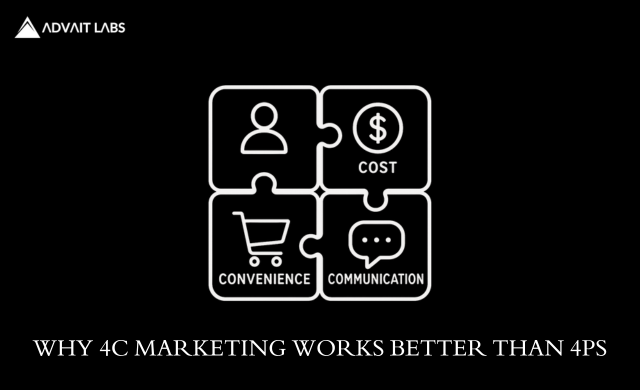The 4C Marketing Explained: A Simple Guide

In today’s competitive world, businesses need more than just traditional strategies to stand out. That’s where 4C marketing comes into play. Unlike the old 4Ps model, which focused heavily on the product and company, the 4Cs put the customer at the heart of every decision. For growing companies like Advait Labs in Hyderabad, understanding and applying the 4C framework is crucial for building stronger relationships and driving sustainable growth.
This guide will break down each element of the 4C marketing model, explain why it’s more effective than older approaches, and show you how to apply it in real business situations.
What is 4C Marketing?
4C marketing is a customer-centric framework designed to replace the traditional 4Ps (Product, Price, Place, Promotion). Introduced by Robert F. Lauterborn in the 1990s, the model emphasizes understanding customer needs rather than simply pushing products into the market.
The 4Cs stand for:
- Customer (wants and needs)
- Cost (to satisfy)
- Convenience
- Communication
This shift encourages businesses to build strategies based on delivering real value, creating trust, and engaging customers in meaningful ways.
Why Shift from 4P to 4C Marketing?
The old 4Ps worked well when markets were less competitive, and consumers had fewer choices. But today, customers are more informed, demand personalized experiences, and have access to countless alternatives.
Here’s why 4C marketing makes sense:
- Customer-first approach: Focuses on solving problems instead of selling products.
- Builds loyalty: By understanding needs, businesses build stronger, long-term relationships.
- Better communication: Engages customers across digital platforms, not just through advertising.
- Adaptable: Works for both small businesses and global enterprises.
Breaking Down the 4C Marketing Model
1. Customer (Wants and Needs)
The first “C” emphasizes understanding what customers truly want. It’s no longer about creating a product and then finding buyers—it’s about identifying customer pain points and designing solutions.
Key questions to ask:
- What problems are customers trying to solve?
- How does this product/service improve their life?
- Are we addressing emotional as well as practical needs?
Example: Advait Labs in Hyderabad designs digital solutions by studying client challenges in detail. Instead of pushing pre-made tools, they customize software that fits specific business requirements.
2. Cost (To Satisfy)
“Cost” goes beyond just the price tag. It considers the total value exchange—time, effort, and even emotional cost.
Factors that make up cost:
- Financial expense
- Time required to use the product/service
- Risk associated with purchase
- Opportunity cost (choosing one product over another)
Tip: Communicate clearly why your product is worth the investment. Customers often pay more if they feel the value is greater than the cost.
3. Convenience
Today’s buyers prioritize convenience over everything else. If your product or service isn’t easy to find, purchase, or use, customers will move to a competitor.
Ways to improve convenience:
- Offer online purchasing and delivery options
- Simplify product usage with tutorials and support
- Ensure availability across multiple platforms
- Use technology to reduce friction in customer journeys
Example: E-commerce platforms have succeeded because they bring products to customers’ doorsteps—saving time and effort.
4. Communication
Unlike “promotion” in the 4Ps, communication is two-way. Customers no longer want to be “sold to”; they want brands to listen, engage, and build trust.
Effective communication includes:
- Interactive social media engagement
- Personalized email marketing
- Transparent customer service
- Gathering feedback and acting on it
Brands like Advait Labs show how 4C marketing thrives by using real communication strategies—listening to client needs and collaborating to create solutions instead of just promoting their services.
Advantages of 4C Marketing
- Stronger customer loyalty through genuine connection
- More efficient marketing spend by targeting real needs
- Increased word-of-mouth referrals thanks to satisfied customers
- Flexibility in strategy that adapts to market shifts
How to Apply 4C Marketing in Your Business
- Research deeply: Use surveys, analytics, and direct conversations to uncover customer needs.
- Redefine cost: Focus on overall value delivered, not just lowering price.
- Simplify access: Improve your product/service convenience at every stage.
- Engage meaningfully: Build two-way communication across multiple touchpoints.
Conclusion
4C marketing is not just another marketing theory—it’s a practical framework that puts customers at the center of everything. Businesses that adopt this model don’t just sell products; they create experiences that build loyalty and long-term success.
Whether you’re a small business owner or a company like Advait Labs in Hyderabad, applying the 4C marketing model will help you stand out in today’s crowded market. By focusing on Customer, Cost, Convenience, and Communication, you’ll transform the way you connect with your audience.
FAQs on 4C Marketing
1. What is 4C marketing in simple terms?
4C marketing is a customer-focused approach where businesses focus on Customer needs, Cost, Convenience, and Communication instead of the traditional 4Ps.
2. How is 4C marketing different from 4P marketing?
The 4Ps focus on the product and company, while 4C marketing shifts the focus to the customer, ensuring strategies meet real needs.
3. Why is convenience important in 4C marketing?
Convenience ensures that customers can easily access and use your products, which is critical in today’s fast-paced market.
4. How does Advait Labs use the 4C marketing model?
Advait Labs in Hyderabad applies 4C marketing by customizing solutions based on customer needs, ensuring convenience through technology, and building strong communication channels.
5. What are the benefits of using 4C marketing for small businesses?
For small businesses, 4C marketing helps build customer trust, improve loyalty, reduce wasted marketing spend, and create long-term growth opportunities.
